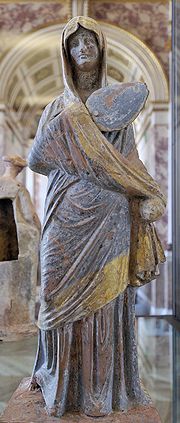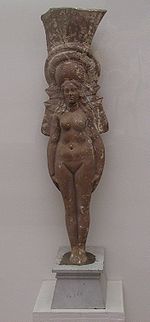
Tanagra figurine
Encyclopedia

Greek Terracotta Figurines
Terracotta figurines are a mode of artistic and religious expression frequently found in Ancient Greece. Cheap and easily produced, these figurines abound and provide an invaluable testimony to the everyday life and religion of the Ancient Greeks.-Modelling:...
produced from the later fourth century BCE, primarily in the Boeotia
Boeotia
Boeotia, also spelled Beotia and Bœotia , is one of the regional units of Greece. It is part of the region of Central Greece. It was also a region of ancient Greece. Its capital is Livadeia, the second largest city being Thebes.-Geography:...
n town of Tanagra
Tanagra
Tanagra is a town and a municipality north of Athens in Boeotia, Greece. The seat of the municipality is the town Schimatari. It is not far from Thebes, and it was noted in antiquity for the figurines named after it...
. They were coated with a liquid white slip before firing and were sometimes painted afterwards in naturalistic tints with watercolors, such as the famous "Dame en Bleu" ("Lady in Blue") at the Louvre (illustration). Scholars have wondered why a rural place like Tanagra produced such fine and rather "urban" style terracotta figures.
Tanagra figures depict real women — and some men and boys — in everyday costume, with familiar accessories like hats, wreaths or fans. Some character pieces may have represented stock figures from the New Comedy of Menander
Menander
Menander , Greek dramatist, the best-known representative of Athenian New Comedy, was the son of well-to-do parents; his father Diopeithes is identified by some with the Athenian general and governor of the Thracian Chersonese known from the speech of Demosthenes De Chersoneso...
and other writers. Others continued an earlier tradition of molded terracotta figures used as cult image
Cult image
In the practice of religion, a cult image is a human-made object that is venerated for the deity, spirit or daemon that it embodies or represents...
s or votive objects. Typically they are about 4 to 8 inches high.
The coraplasters, or sculptors of the models that provided the molds, delighted in revealing the body under the folds of a himation
Himation
A himation was a type of clothing in ancient Greece. It was usually worn over a chiton, but was made of heavier drape and played the role of a cloak.The himation was markedly less voluminous than the Roman toga....
thrown round the shoulders like a cloak and covering the head, over a chiton
Chiton
Chitons are small to large, primitive marine molluscs in the class Polyplacophora.There are 900 to 1,000 extant species of chitons in the class, which was formerly known as Amphineura....
, and the movements of such drapery
Drapery
Drapery is a general word referring to cloths or textiles . It may refer to cloth used for decorative purposes – such as around windows – or to the trade of retailing cloth, originally mostly for clothing, formerly conducted by drapers.In art history, drapery refers to any cloth or...
in action.
Discovery
Tanagra figures had not been much noted before the end of the 1860s, when ploughmen of Vratsi in BoeotiaBoeotia
Boeotia, also spelled Beotia and Bœotia , is one of the regional units of Greece. It is part of the region of Central Greece. It was also a region of ancient Greece. Its capital is Livadeia, the second largest city being Thebes.-Geography:...
, Greece, began to uncover tombs ranging in date over many centuries. The main finds especially from the 4th and 3rd centuries BCE were secured in 1874. Inside and outside the tombs of the Hellenistic period — 3rd to 1st centuries BCE — were many small terracotta figures. Great quantities that were found in excavation sites at Tanagra identified the city as the source of these figures, which were also exported to distant markets. In addition, such figures were made in many other Mediterranean sites, including Alexandria
Alexandria
Alexandria is the second-largest city of Egypt, with a population of 4.1 million, extending about along the coast of the Mediterranean Sea in the north central part of the country; it is also the largest city lying directly on the Mediterranean coast. It is Egypt's largest seaport, serving...
, Tarentum
Taranto
Taranto is a coastal city in Apulia, Southern Italy. It is the capital of the Province of Taranto and is an important commercial port as well as the main Italian naval base....
in Magna Graecia
Magna Graecia
Magna Græcia is the name of the coastal areas of Southern Italy on the Tarentine Gulf that were extensively colonized by Greek settlers; particularly the Achaean colonies of Tarentum, Crotone, and Sybaris, but also, more loosely, the cities of Cumae and Neapolis to the north...
, Centuripe
Centuripe
Centuripe is a town and comune in the province of Enna . The city is located 61 km from Enna, in the hill country between the Rivers Dittaìno and Salso.The economy is mostly based on agriculture...
in Sicily
Sicily
Sicily is a region of Italy, and is the largest island in the Mediterranean Sea. Along with the surrounding minor islands, it constitutes an autonomous region of Italy, the Regione Autonoma Siciliana Sicily has a rich and unique culture, especially with regard to the arts, music, literature,...
and Myrina
Myrina (Mysia)
Myrina , was one of the Aeolian cities on the western coast of Mysia, about 40 stadia to the southwest of Gryneion. Its site is believed to be occupied by the modern Sandarlik at the mouth of the Koca Çay....
in Mysia
Mysia
Mysia was a region in the northwest of ancient Asia Minor or Anatolia . It was located on the south coast of the Sea of Marmara. It was bounded by Bithynia on the east, Phrygia on the southeast, Lydia on the south, Aeolis on the southwest, Troad on the west and by the Propontis on the north...
.

Jean-Léon Gérôme
Jean-Léon Gérôme was a French painter and sculptor in the style now known as Academicism. The range of his oeuvre included historical painting, Greek mythology, Orientalism, portraits and other subjects, bringing the Academic painting tradition to an artistic climax.-Life:Jean-Léon Gérôme was born...
created a polychromatic sculpture depicting the spirit of Tanagra, and one French critic described the fashionable women portrayed in the statuettes as "the parisienne of the ancient world". Oscar Wilde
Oscar Wilde
Oscar Fingal O'Flahertie Wills Wilde was an Irish writer and poet. After writing in different forms throughout the 1880s, he became one of London's most popular playwrights in the early 1890s...
in his play An Ideal Husband
An Ideal Husband
An Ideal Husband is an 1895 comedic stage play by Oscar Wilde which revolves around blackmail and political corruption, and touches on the themes of public and private honour...
(1895), introduces the character of Mabel Chiltern with (amongst further description) "she is really like a Tanagra statuette, and would be rather annoyed if she were told so." Under the pressure of collectors' demands, Tanagra terracottas began to be faked.
External links
- A charming figurine with well-preserved coat of paint (Hermitage Museum)
- A Closer Look at the Tanagra figurine called the Titeux Dancer (Louvre museum)
- (Metropolitan Museum) Tanagra figurines
- Persephone with the pomegranate, Tanagra figurine with traces of white slip (Louvre)
- (Louvre) Several Tanagra figures
- Antoine Zink and Elisa Porto, "Luminescence dating of the Tanagra terracottas of the Louvre collection", 2005. (pdf file)
- Tanagra le petit peule d'argile
Further reading
- Minna Lönnqvist (1997) "Nulla signa sine argilla" - Hellenistic Athens and the Message of the Tanagra Style, in Early Hellenistic Athens, Symptoms of a Change, ed. by Jaakko Frösén, Papers and Monographs of the Finnish Institute at Athens, Vol. VI, Vammala, 147-182+ 14 illustrations + sources.

